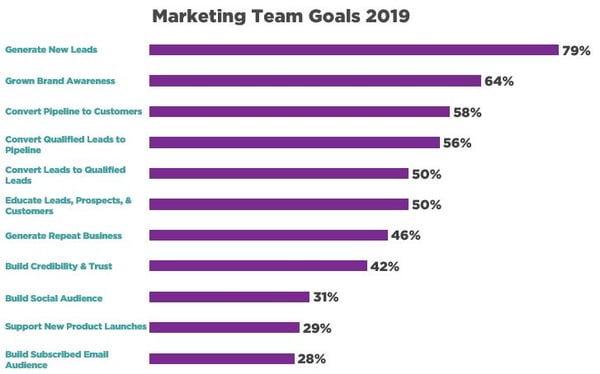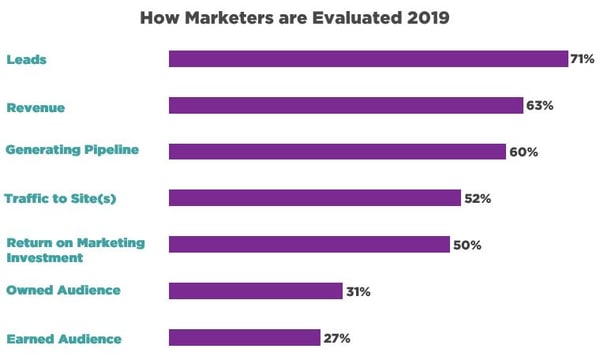For some departments and job roles, things are straightforward. The goal of Sales is to drive as much business as possible, so they get out there and hit their targets to earn commission and bonuses. The C-Suite needs to grow the business as big and as quickly as possible; that’s what they’re evaluated on, and a job well done is nicely reflected in their stock options.
What about marketing, though? Are marketing goals and how marketers are evaluated well aligned? It’s something I know I’m curious about, and I imagine you are too.
In today’s blog post I plan to answer that question, thanks to data generated from a recent survey on the budgets and strategies of 113 marketers working in the industrial and technology marketing space.
P.S. We’re currently crunching the numbers and will be providing a full analysis in our upcoming webinar: Industrial & Technology Marketing Trends 2019, which we’ll host on February 21st. If you wanted to know where your peers are investing and what marketing tactics are providing value, then this webinar is for you!
Big Picture: Marketing Team Goals and Marketer Metrics of Evaluation
Before we start asking about alignment between goals and metrics, let’s first get a sense of each on their own.
To understand the goals of the marketing departments the respondents represented, they were asked the following question: Which of the following are goals of your marketing team in 2019? Select all that apply. The table below shows the results:

The results are in line with what one would expect, at least for ordering. The hallmarks of marketing: Leads, awareness and moving prospects through the funnel dominate the first five slots.
Next, let’s take a look at how marketers are being evaluated. This was assessed by the following question: Which metrics are you measured on? Please select all that apply. Here are the results:

Leads being at the top of the evaluation metrics list is a relief, as they go hand-in-hand with the top two results from the list of goals: New Leads and Brand Awareness. Likewise, Revenue lines up nicely with “Convert Pipeline to Customers,” as does Generating Pipeline with “Qualified Leads to Pipeline.”
While on the surface the goals and metrics look all nice and cozy, we’re able to dig a little deeper by cross-referencing the two charts above. We can also exercise some critical thinking and ask whether the goals being pursued are the right ones given how marketers are being evaluated. In the upcoming webinar we’ll look at each metric of evaluation, but today—to keep this blog from exploding in word count—let’s look at the most popular one: Leads.
Leads Top both Goals and Evaluation Criteria, But Are They Sufficiently Aligned?
The table below shows the percentage of marketers being evaluated on leads who also said their team was responsible for the goals listed on the vertical axis.
 The first thing that should stand out is that for marketers being evaluated on Leads, only 84% of them said their team’s goals included Generating New Leads. If this were 95% or so, we could probably chalk the result up to random error, but that 16% gap is sizeable. This signals a very serious disconnect on some teams, but it’s not the only standout result.
The first thing that should stand out is that for marketers being evaluated on Leads, only 84% of them said their team’s goals included Generating New Leads. If this were 95% or so, we could probably chalk the result up to random error, but that 16% gap is sizeable. This signals a very serious disconnect on some teams, but it’s not the only standout result.
To me, the most puzzling result of the above list of goals is the meager respect paid to audience growth via email subscription and social audience. These are two easily quantifiable measures, and directly correlate with lead generation.
For many prospects, their first several interactions will be through content, whether that content is written, video, or some other medium such as an infographic. The earliest and simplest possible conversion in a marketing funnel is from an unknown visitor to a subscriber, whether that be to an email list or social media account. 58%, 61%, and 65% of marketers being evaluated on leads concern themselves with conversions at later steps down the funnel (MQL à Pipeline à Customer), so why are so many teams deemphasizing the earliest step in the conversion pathway?
The two above examples of goal/metric misalignment are very quantifiable. However, not all goals need to be or even should be quantifiable. For example, when trying to generate leads, creating content that is educational and also builds credibility and trust is paramount to success.
We’ve seen this most recently with engineering.com’s own experience with Research Reports. These reports, based on survey research (just like this post), resonate with the engineering audience more so than other forms of content because of their dense educational content credibility. The results are staggering, averaging a 225% increase in downloads (e.g. new leads) over other forms of content like whitepapers.
The power of trust and credibility cannot be understated. While not dealing specifically with new leads, How Engineers Find Information 2019 determined via a survey of more than 1,500 engineers that over 40% of senior leaders would request a proposal from a company based on excellent thought leadership. Clearly, credible, trustworthy and educational content can contribute to leads, if not pipeline and revenue.
What about Revenue, Traffic, and Pipeline?
Glad you asked. We’ll take a similar look at these metrics during the upcoming webinar. If you enjoyed this analysis, I encourage you to click here to sign-up. We’ll be holding the webinar on February 21st at 2 pm ET. I hope to see you there.
Thanks for reading and sharing,
Andrew






